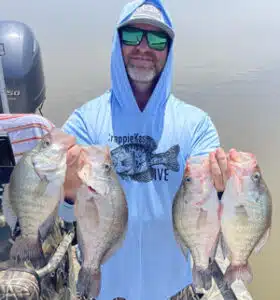WE ARE YOUR SOURCE FOR FISHING DESTINATIONS IN ALABAMA!
Mastering Summer Crappie Fishing on Alabama's Rivers

When the scorching days of summer arrive, many anglers trade in their fishing gear for other pursuits. However, if you’re a crappie enthusiast, here’s the scoop from guide Shane Jones on why, where, and how to make the most of your summer crappie fishing adventures.
By Eileen Davis
“Summer is my favorite season to fish for crappie,” says crappie guide Shane Jones, a passionate angler with years of experience on the water. He goes on to explain, “May and June are undoubtedly the peak months for crappie fishing. The bite is on fire during this period. Although the action might slow down a bit in July and August due to the heat, September is still very much a part of the summer for me.”
Jones, whose love for fishing goes back decades, reminisces about his own shift in perspective. “I used to hang up my fishing rod once summer kicked in, and I’d wait until September, coinciding with the start of Alabama’s football season. But one fateful July, everything changed. We were at a boat race, casually sipping on some beers, when a crazy idea struck me – let’s go fishing.”
And that spontaneous decision turned out to be a game-changer. “We took the boat to the other side of Demopolis Lake,” Jones said, “and when I dropped my Live Scope, I couldn’t believe my eyes. The screen was alive with crappie covering a tree. In July! We caught over 40 fish that evening, with some weighing up to two pounds. That was the turning point – I realized summer fishing could be incredibly rewarding.”
Finding Crappie
Finding crappie, which are structure-oriented fish, during summer demands some scouting finesse. Scouting for locations on a river to find crappie during the summer is crucial for many reasons, but most important are structures and cover.
Jones continued, “I can’t stress this enough: scouting is key. During summer, crappie hang around river ledges and feed on adjacent flats. River channel bends with flooded timber or blowdowns are prime spots. And places where the river swings next to the bank with flooded timber and reeds, is another place where you’ll likely find crappie.
“Use side scan technology to locate stumps and brush piles. The magic happens when you find substantial, long-standing cover, like stumps with their roots exposed from current. Once you have marked several stumps or brush piles, use Live Scope to see if they hold crappie.”
Another factor in finding crappie is mud. They are known for sometimes congregating near the bottom, especially in areas with muddy substrates. Being on the bottom offers them a good vantage point to strike passing prey and may help insulate them from rapid temperature changes occurring in shallow water.
“White crappie,” Jones said, “love to bury themselves in the mud when the barometric pressure is high, and they tend to stay shallow during summer. Look for reeds, as these areas have soft mud bottoms. This is the opposite of what bass anglers do, as crappie prefer to stay away from clay bottoms.”
Fishing Techniques
Jones’ tackle is a 6-foot custom spinning rod by Lost Creek Custom Rods spooled with 8-pound braid. His weedless jig heads are handmade by Timmy Toms and are dressed with soft plastics from Limits Tackle. Jones’ favorite colors are blue monkey milk and chartreuse and black. When crappie become picky as they often do during July and August, Jones switches to a chartreuse and black hair jig made by Ruben Flores. All jigs have size 2 hooks and weigh 1/16 ounce.
Instead of casting his jigs, Jones shoots his lures (see his video below). It takes a little practice, but it’s accurate and it doesn’t make contact with the sun umbrella.
This is how Jones picks apart a brush pile in summer: “On the first cast, I’ll retrieve my bait about three to four feet above the brush pile. The exact distance depends on water clarity. If the water is murky, I’ll keep the bait closer to the fish. This targets aggressive fish, the ones that are keen on chasing after food.
“For my next cast, I’ll aim for the middle of the group of fish. If they don’t seem interested in biting, I’ll maneuver my boat a bit closer to the brush pile and let the bait stay still in the water. I’ll only reel it in a tiny bit.
“If that approach doesn’t get results, I’ll try reeling the bait through the brush pile. As I do this, I’ll give my fishing rod a quick two- or three-inch snap to see if that triggers a reaction bite.
“If even that doesn’t work, I won’t waste too much time. I’ll move on to the next brush pile. Instead of stubbornly trying to make those fish bite, I’ll adapt and switch locations.
“Usually, during this time of year, it’s typical to catch only two or three crappie from a brush pile. So, it’s good to keep expectations realistic.”
Jones says that once you establish a pattern, such as clarity, cover, currents, depth, structure, and temperature, it is repeatable on the river.
“When you find a summer pattern,” he said, “stick with it. Repetition is the key to success. The river might throw challenges your way, but that’s what makes it all the more rewarding.”
Jones guides anglers on Demopolis and Millers Ferry lakes, two prime fishing destinations with low fishing pressure.
You can contact and follow Shane Jones on Facebook, Instagram and YouTube. Every Thursday night, Jones hosts CrappieKast Live on Facebook. Past episodes are available on Youtube. You can also contact him at (205) 837-1839.
Jones is also a reporter on Getting Outdoors Radio.
Click here to read more about how successful anglers find and catch Bama’s fish.
PLEASE SHARE
